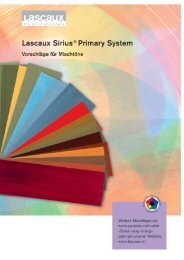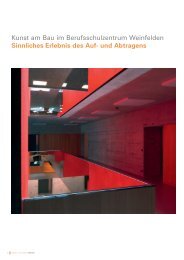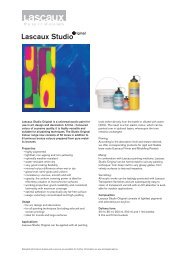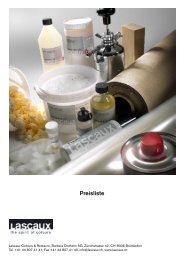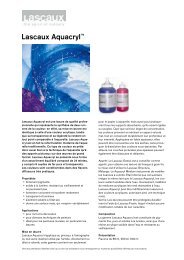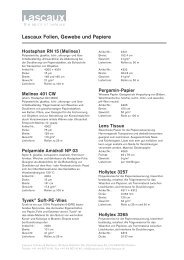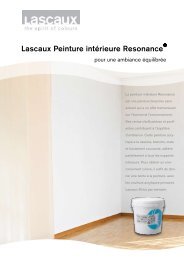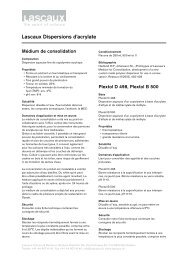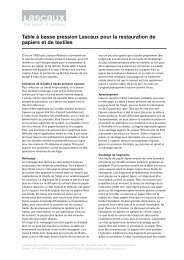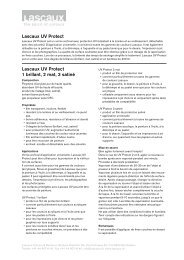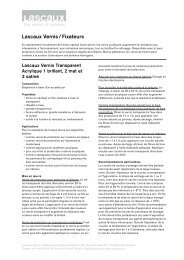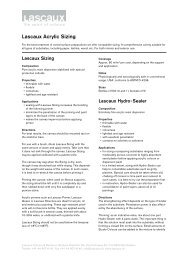Lascaux Tusches - Lascaux Colours & Restauro
Lascaux Tusches - Lascaux Colours & Restauro
Lascaux Tusches - Lascaux Colours & Restauro
Create successful ePaper yourself
Turn your PDF publications into a flip-book with our unique Google optimized e-Paper software.
Airbrush techniques<br />
A simple airbrush can be used to apply the undiluted<br />
tusche in even layers over the <strong>Lascaux</strong> Lift Solution<br />
image until it is covered. Alternatively the airbrush can be<br />
used as a drawing instrument. The airbrushed dots<br />
resemble aquatints or tonal effects. Stencils can be used<br />
to build up an image. The sprayed areas will ultimately<br />
print. The airbrush should be rinsed thoroughly with water<br />
after use.<br />
<strong>Lascaux</strong> Tusche waterproof<br />
Composition<br />
Aqueous dispersion of acrylic polymer with pigment<br />
Special characteristics<br />
Fast drying, waterproof and scuff resistant, this semiviscous<br />
tusche has homogenous covering power and is<br />
useful for a broad range of painted marks. The diluted<br />
tusche dries to resemble ‘toad-skin’ washes usually<br />
found in zinc-plate lithography.<br />
Working practice<br />
Work on a clean white horizontal surface or a lightbox.<br />
Use a china or glass bowl as a palette. Brushes, paint<br />
shapers, and rags can be used to make marks. The<br />
marks will dry quickly and will not bleed when layers of<br />
other tusches are painted on top. The painted areas will<br />
ultimately print. Brushes and tools should be cleaned<br />
before the tusche dries on them.<br />
<strong>Lascaux</strong> Tusche water-soluble<br />
Composition<br />
Aqueous dispersion of vinyl acetate copolymer with<br />
pigment<br />
Special characteristics<br />
This viscous tusche can be painted in a smooth even<br />
layer which can be scratched away to create delicate<br />
non-printing lines. It can also be used for a broad range<br />
of painted marks, offsetting and pattern-making. The<br />
diluted tusche dries to create characterful granular<br />
washes. Dry marks can be re-wet and altered if required.<br />
Working practice<br />
Work on a clean white horizontal surface or a lightbox.<br />
Use a china or glass bowl as a palette. Brushes, paint<br />
shapers, rags and sponges can be used to make marks.<br />
Patterns can be created by offsetting materials such as<br />
painted card stencils, linocuts, printing blocks, embossed<br />
paper, leaves or feathers. Blotting paper can be used to<br />
apply or lift off the tusche. The Tusche can be used<br />
directly from the bottle or diluted. The painted areas will<br />
ultimately print.<br />
Drawing techniques<br />
Smooth PVC sheet and a watercolour wash brush are<br />
required for these techniques. One method is to draw<br />
into a flat painted layer of <strong>Lascaux</strong> Tusche water-soluble<br />
while it is still wet. Paint shapers, the ends of brushes or<br />
cotton buds can be used to generate lines of different<br />
types. Another method is to paint a thin and even layer of<br />
tusche on a sheet of smooth transparent PVC sheet.<br />
When this is completely dry a drawing can be made<br />
using etching tools or other materials, such as wire wool.<br />
The delicate lines created will be non-printing.<br />
<strong>Lascaux</strong> Tusche soft-ground<br />
effect<br />
Composition<br />
Aqueous dispersion of polyvinyl alcohol with pigment<br />
Special characteristics<br />
This slow drying viscous tusche has been designed to<br />
produce effects similar to soft ground in traditional<br />
etching. Using this method soft non-printing drawings<br />
may be made and impressions of fabric, leaves, feathers<br />
and other collage materials may be taken. The tusche can<br />
also be used for a broad range of painted marks and can<br />
be drawn into with paint shapers and other tools. The<br />
diluted tusche dries to create granular washes. Dry marks<br />
can be re-wet and altered.<br />
Working practice<br />
Work on a clean white horizontal surface or a lightbox.<br />
Use a glass slab to roll out the tusche or if painting use a<br />
china or glass bowl as a palette. A soft polyvinyl hand<br />
roller is ideal. A warm fan or warm printmaking drying<br />
cabinet will speed up the drying time.<br />
Making collage-based images<br />
Cut two sheets of smooth PVC sheet to a slightly larger<br />
size than the image. Check that the sheets fit the etching<br />
press bed and can be covered by the blankets. Then,<br />
working on a clean work surface masking-tape the<br />
corners of one sheet down and roll the tusche out thinly<br />
to form a smooth flat area in the centre of the sheet.<br />
Impressions can be taken immediately or for up to 90<br />
minutes after rolling out the tusche. The results will be<br />
different depending on how dry the tusche is. Position<br />
the prepared sheet on the press bed and arrange a<br />
collage of low-profile textured materials such as feathers,<br />
leaves, threads and paper shapes on top of the tusche.<br />
Avoid wire, chain links or other hard objects that will<br />
cause damage to the blankets or press. The second<br />
sheet of thin transparent smooth PVC is laid on top of<br />
the collage, followed by some clean sheets of tissue and<br />
the blankets of the etching press.<br />
The two sheets and the collage are rolled through the<br />
etching press. The image will vary depending on the<br />
pressure, which can be decreased by removing a blanket.



